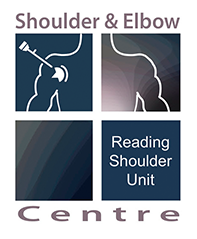Arthroscopic / Open stabilisation of the shoulder
Print PdfPatient leaflet - Arthroscopic Stabilisation
INTRODUCTION
The shoulder joint is designed to give a large amount of movement. Therefore support from the ligaments and muscles is essential.
When the shoulder dislocates the ligaments can be torn or stretched and in some cases need to be repaired.

The Operation
The operation involves repairing the over-stretched or torn ligaments deep around the shoulder joint. If suitable, the surgeon may perform Arthroscopic (Keyhole) Stabilisation.
General Guidelines
PAIN:
A nerve block is usually used during the surgery. This means that immediately after the operation the shoulder and arm often feel completely numb. This may last for a few hours. After this the shoulder may well be sore and you will be given painkillers to help this whilst in hospital. These can be continued after you are discharged home. Ice packs may also help reduce pain. Wrap crushed ice or frozen peas in a damp, cold cloth and place on the shoulder for up to 15 minutes.
WEARING A SLING:
You will return from theatre wearing a sling. The surgeon/physiotherapist will advise you on how long you are to continue wearing the sling. This is usually for 6 weeks. You will be expected to remove the sling for exercises only. Your physiotherapist will advise you of these.
THE WOUND:
- Open stabilisation: There is an incision at the front of the armpit within the natural skin crease. The stitch is dissolvable but is usually removed at 3 weeks. Keep the wound dry until it is well healed.
- Arthroscopic (keyhole) stabilisation: This keyhole operation is usually done through two or three 5mm puncture wounds. There will be no stitches only small sticking plaster strips over the wounds. These should be kept dry until healed. This usually takes 5 to 7 days.
DRIVING:
You will not be able to drive for a minimum of 8 weeks. Your surgeon will confirm when you may begin.
RETURNING TO WORK:
This will depend upon the size of your tear and your occupation. You will need to discuss this with your surgeon.
LEISURE ACTIVITIES:
Again this will depend upon the size of the tear. Your physiotherapist and surgeon will advise you when it is safe to resume your leisure activities.
FOLLOW UP APPOINTMENTS:
An appointment will be made for you to be reviewed at The Shoulder Unit at 3 weeks. You will be monitored by a physiotherapist throughout your rehabilitation with formal physiotherapy normally beginning 6 weeks after surgery.
Exercises:
The shoulder must remain immobilised with a sling and a body belt (underneath the clothes) for 3 weeks. At your follow-up appointment the body belt will be removed and you will be allowed to wear the sling on top of your clothes.
You will perform first only elbow, wrist and hand exercises.
You may well be expected to perform the following exercises when you leave hospital. Please check with your physiotherapist before commencing.
- Keep your arm in the sling and move your hand up and down at the wrist.
- With your arm out of the sling bend and straighten the elbow
- With your arm in the sling and the elbow bent at your side, turn the hand to face the ceiling and then the ground.
- With arm in the sling regularly shrug shoulders up and down and circle forwards and backwards
Repeat these exercises four times per day. The number you should perform at each session will be recorded for you by your physiotherapist.
Continue these exercises until otherwise advised by your physiotherapist.
If you require further information please discuss this with the doctors either in clinic or on admission.
